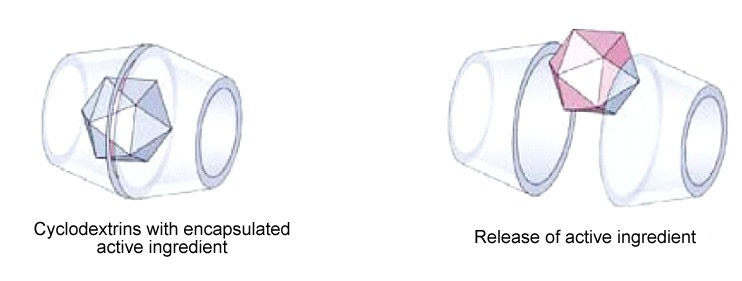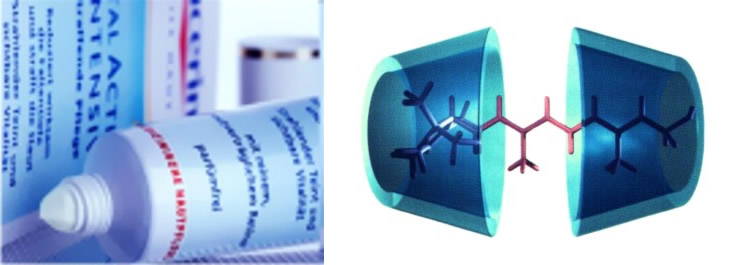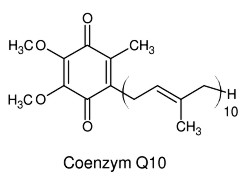Cyclodextrins used in cosmetic applications benefit from the same advantages as cyclodextrins used in food. Many ingredients in cosmetics are unstable and break down quickly when exposed to atmospheric oxygen and light. This includes in particular the increasingly popular active ingredients in anti-aging products. These active ingredients are hosted inside complexes with cyclodextrin molecules to protect them from air and light. |
||||||||||||||||
 |
||||||||||||||||
| Fig. 1.52: The active ingredients in anti-aging cosmetics are highly sensitive and must be protected from air and light | ||||||||||||||||
| After the products have been applied to the skin, the moisture in the skin triggers the release of the active ingredients at a controlled rate. | ||||||||||||||||
| |
||||||||||||||||
 |
||||||||||||||||
| Fig. 1.53: Dissociation of the host-guest complexes is triggered by the moisture in the skin, leading to controlled release of the active ingredient | ||||||||||||||||
| Stable Anti-Aging Active Ingredients with Cyclodextrin | ||||||||||||||||
The controlled release of retinol has a further advantage in addition to protecting it from the effects of oxygen and light. Just 0.1% of wrinkle-busting retinol in a cream can cause skin irritation. But when formulated with cyclodextrin as an inclusion complex, much higher concentrations of the active ingredient can be added to cosmetics without causing skin irritation, since the retinol is released gradually. This significantly increases the effectiveness of the anti-aging product. |
||||||||||||||||
 |
||||||||||||||||
| Fig. 1.54: Creams containing the retinol-cyclodextrin complex are already on the market | Fig. 1.55: The retinol molecule is encapsulated by two γ-cyclodextrin molecules | |||||||||||||||
 |
||||||||||||||||
| Fig. 1.56: Vitamin E acts as a free-radical scavenger, thus preventing premature skin aging | Fig. 1.57: Due to the reduction in the ozone layer, our skin is exposed to more UV radiation, which encourages the formation of free-radicals | |||||||||||||||
Vitamin E (tocopherol) is another important anti-aging substance. Like retinol, it is ideal for complexation with cyclodextrins. This is because the lipophilic substances can be readily accommodated by the hydrophobic cavity of the cyclodextrin molecules. Vitamin E also intervenes in the skin-aging process by mopping up free-radicals generated by interaction of oxygen, reactive compounds and UV radiation. Free-radicals trigger reactions which damage the cell membranes. This facilitates the diffusion of water through the cell walls. The water-binding capacity diminishes, causing the skin to become dry and wrinkled. The reactions also change the collagen fibers in the skin and cause the skin to lose its elasticity. Climate changes in recent decades have increased the level of skin exposure to radiation, and consequently anti-aging substances are now used in cosmetics for all ages. Improving the stability of sensitive vitamin E in the host-guest complex has come so far that it is now possible to apply a coat containing vitamin E to metallic surfaces at temperatures of 220° C. Razor blades treated in this way release skin-conditioning tocopherol during shaving. In Figure1.58 the fading red color shows that the tocopherol content decreases considerably more slowly on a razor blade treated with a mixture of vitamin E and γ-cyclodextrin (bottom razor blade), than on a razor blade treated only with tocopherol (top razor blade). |
||||||||||||||||
 |
||||||||||||||||
| Fig. 1.58: The razor blade releases skin-conditioning vitamin E onto the skin during shaving | ||||||||||||||||
|
||||||||||||||||
 |
||||||||||||||||
| Fig. 1.59: Coenzyme Q10 forms oily globules in water that render it impossible to use in water-based products | ||||||||||||||||
In the cosmetic sector, cyclodextrins are not only used as loaded complexes. In self-tanning lotions, cyclodextrin molecules can encapsulate unpleasant smells which arise during tanning. Self-tanning lotions contain 1.5 % γ-cyclodextrin. Other cosmetic applications focus predominantly on the scent and deodorizing properties of guest components. WACKER’s product range also includes cyclodextrin complexes. Table 1.9 summarizes the benefits of complexation and the effect on guest components. |
||||||||||||||||
|
||||||||||||||||
| Table 1.9: Summary of additional cyclodextrin complexes produced by WACKER CHEMIE AG | ||||||||||||||||
Textile manufacturing uses the ability of cyclodextrins to form complexes and the possibility of the controlled release of guest components. For, cyclodextrin molecules which are bonded to textile fibers by an anchor molecule can be charged with active ingredients or aromas. For example, cyclodextrin molecules anchored in textile fibers could be charged initially with farnesol, which is released when the textiles are worn and especially during perspiration, thereby triggering its deodorizing effect. The free cyclodextrin molecules can then absorb sweat components and in this way prevent the formation of odors. |
||||||||||||||||
References:
|
||||||||||||||||
| | Home | Wuppertal University | WACKER | Didactic Dept. | Supp. Info | Experiments | Media | Contact | | ||||||||||||||||